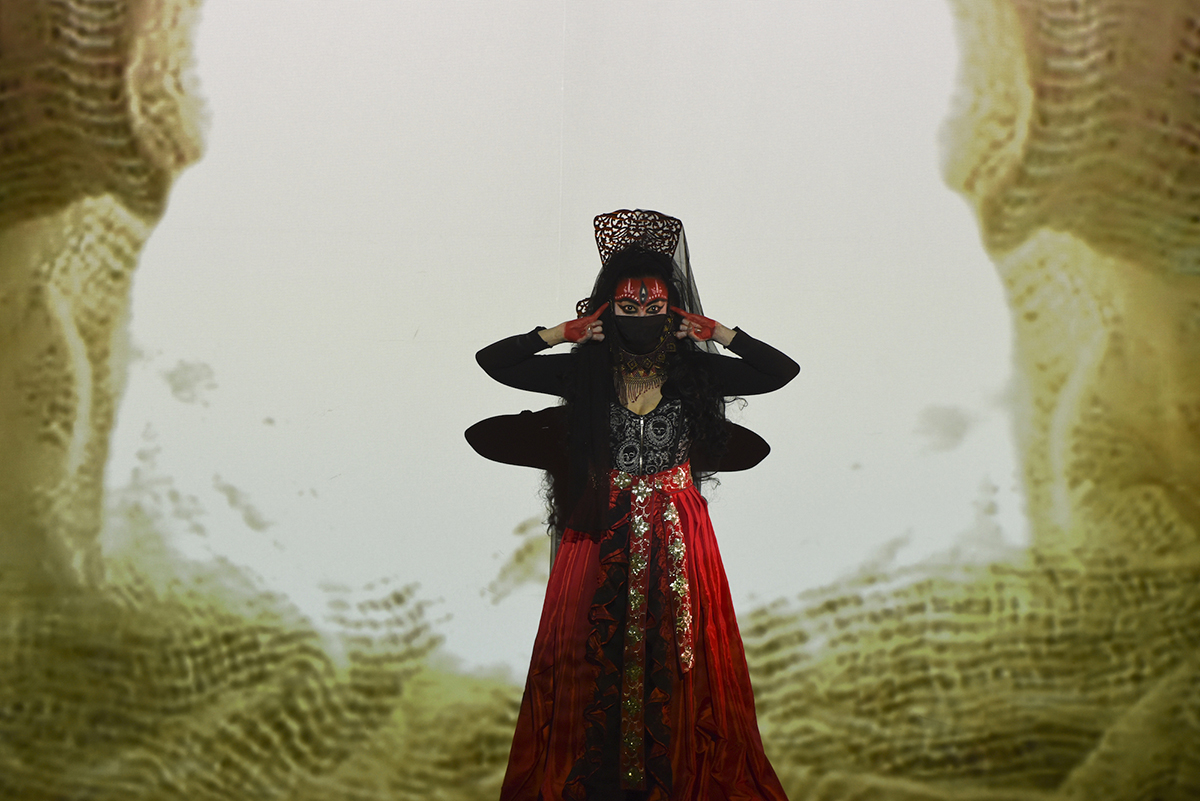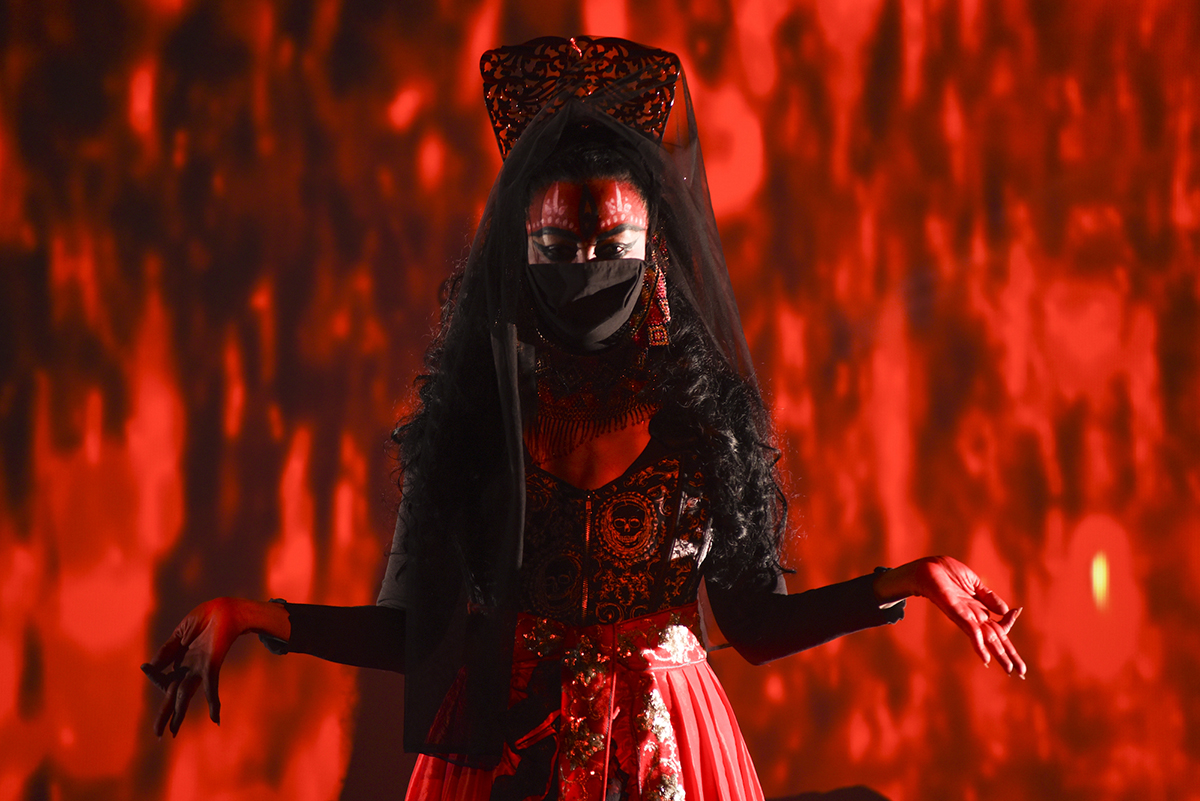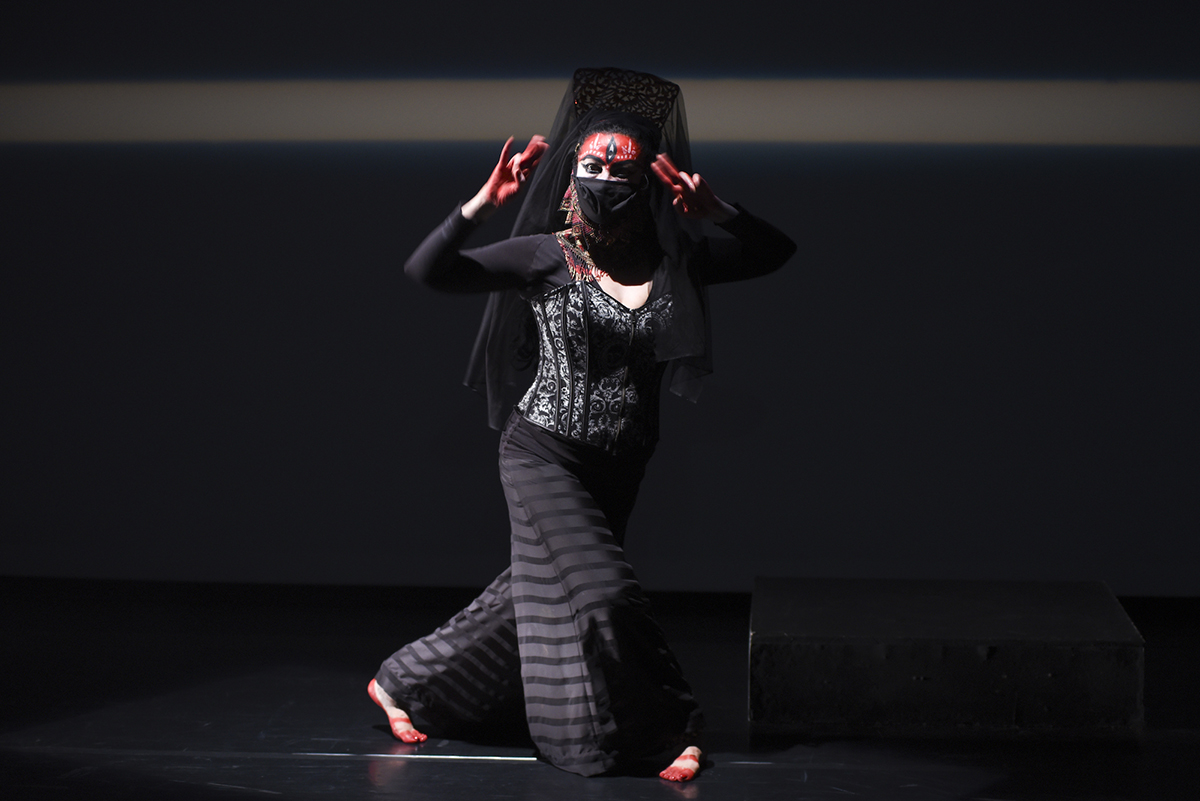
Urban Kali: Face to face with Kali
An urban Kali? What’s in it for me? Very briefly a student of Indian history, I read of Britain’s suppression in the 19th century of the thuggee, a 600-year-old cult whose members murdered, often for profit, in the name of a four-armed, variously black or blue-faced, bloody-tongued Hindu goddess wearing a necklace of skulls. At her grimmest in black, Kali is at her most radiant when glitteringly bejewelled and frocked in swathes of colour. She is, alternatively, a demonic figure driving us unsparingly into the void, or a glorious generator of new life, though her eyes are as piercingly fearsome in both incarnations. Like many an ancient god, she is, of course, both destroyer and maker, inherently spinning the wheel of life and encouraging philosophical acceptance.
An ancient diagram turns slowly in the film that opens the performance of Urban Kali, at its centre images of the goddess, each embodied by Rakini Devi, staring eyes and dancing fingers in close-up, all veiled behind shooting flames. This is Kali as mutable and mysterious and, ever so briefly, literally urban. Garbed in black, she stands against a building as passing cars blur ephemerally. The accompanying music too is contemporary urban, not faux Indian; it breathes like an agitated monster, signalling this is our Kali, now, but irrevocably ancient, as the ritualistic stage framing suggests. A lone skull sits front and centre. To one side is a vivid installation — a miniature pandal, a temporary street temple made for festivals — built around a tiny statuette of Kali. Mid-left, is an enigmatic tall fabric cone, dressed with a chain of skulls and red thread evoking the blood often seen on Kali’s tongue.

Rakini Devi, Urban Kali, photo Heidrun Löhr
Devi/Kali steps into this ceremonial space, hands aloft, drawing behind her a long swathe of red sari cloth. The thump and soft belling of the music confirm that hers is a procession in which the sari is laid as a path along which she treads with gentle steps and spare gestures before gathering it up as if, like blood, it’s a sacred substance. In tandem, the music intensifies, chugging, rattling, grinding and introducing the first of a series of unnervingly shrill chords alongside fluted cosmic winds. Kali, in black save for a gold-threaded skirt, features invisible, is still remote, elegant, but the sounds that surround her intimate danger. In the film that ensues, we are in jolting proximity with the goddess in close-ups of demanding eyes and red-daubed dancing feet juxtaposed with a growling meditative “Ommmm…” Devi’s voiceover celebrates love for the goddess — her feet, her skin (the deepest of close-ups) — and the void, the blackness, she embodies. We have come closer to Kali, and Devi, and nearer again when the goddess dances. Bands of soft colour vibrate across the screen before which Kali stands, one focused solely on her eyes. Staccato drumming settles into a regular pulse and the body, covered in black, breaks into wide-stanced, right-angled articulations, stampings, red-palmed hands turning in and out.
Kali might symbolise the inevitability of death, but not the rightness of murder. In an utterly chilling film sequence a pair of bloodied hands are suspended directly above a bucket of water in a dance of guilt-laden anguish as Devi explicitly details the horrors of female child murder in India, including the words of some of the perpetrators, victims of another kind. The ensuing dance, with Kali/Devi sliding on her back to the stage and writhing, seems to become a restorative expiation when she sits centrestage, the opening diagrammatic image projected onto the floor from above and her hands and feet turning eloquently in and out. The goddess turns slowly, rolls onto her front, feet and legs rise behind and head and torso lift to create an image of yogic grace. This might be Kali, the mother her many followers believe her to be, and whom we finally meet fully face to face in the last scene in a blaze of glory, framed by a huge image of an eternally deep cave — not black, but a soft haven, a macrocosm seemingly made from a close-up of gently ruffled cloth and textured with a lovely half-melody. Urban and atheist as I am, I might not believe in Kali, but I welcome the emotionally complex connotations that swirl about her and acknowledge that for a secular society she has the power to evoke the sheer scale of the epic recurrency, individual and social, of the glory and the trauma that constitute life and death. Rakini Devi has given me a Kali to keep and reflect on.

Rakini Devi, Urban Kali, photo Heidrun Löhr
Urban Kali is a voyage from dark into light, wonderfully costumed and filmed, finely scored (if at times overwrought) and quite delicately performed by Rakini Devi for all the work’s inherent drama. Not everything felt right. Several segues felt perfunctory and a too-long interlude before the final scene — with music angsting and an indeterminate image flickering on the conical sculpture — proved taxing. The sculpture itself seemed inadequately integrated into the production. I’ve since learned that the projected image in Urban Kali is a yantra, a sacred diagram, and that yantras integratively manifest across architecture, art and science as well as in religion and that the conical sculpture and other elements of the work are also yantras, at once sacred and secular. Devi writes of the cone: “The Kali yantra serves as both ‘receptacle’ and symbolic manifestation of Her attributes. The cone, as the central triangle diagram of many yantras, is symbolic of the female energy personified as the black void of Kali.”
While Devi’s approach to Urban Kali has been to provide a richly impressionistic, if deeply informed, encounter with the goddess, one from which I made my own sense of her, I think that the artist could have provided more information in the program for the audience to take away with them to meaningfully reflect on this fascinating work’s iconography and cosmology and share more of the extensive research Devi has generated for her Doctor of Creative Arts degree. We’re up to it.
–
Read an interview with Rakini Devi about her career, Kali and her postgraduate research at the University of Wollongong.
FORM Dance Projects & Riverside Theatres, Urban Kali, creator, performer Rakini Devi, sound, film designer Karl Ford, lighting Frankie Clarke; Riverside Theatres, Parramatta, Sydney, 22-23 September
Top image credit: Rakini Devi, Urban Kali, photo Heidrun Löhr






